
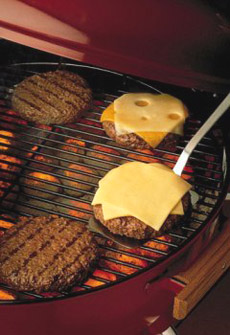
Make your burgers better by starting with the right beef. These delicious burgers are from Ottomanelli Brothers.
June 2007
|
 |
Product Reviews / Main Nibbles / Meat & Poultry
Tips For A Better Burger
You Can Make The Best Burgers: It’s Easy
Ever wonder why your burgers don’t taste as good as the ones at your favorite burger place? You may buy the best meat, have the best grill...still, you’re disappointed?
These tips can turn your burger into as good as it gets.
1. It Starts With The Meat
Certainly, you didn’t expect “ground hamburger” from the supermarket to produce the best burgers. But the finest cut doesn’t do it either—filet mignon, for example, doesn’t have enough fat to give flavor to a burger. Great burgers require a specific portion of fat to meat, and most experts agree that the best burger comes from sirloin or chuck. But not all “ground chuck” is created equal, of course: There are average meats and quality meats. When dairy cows become too old to give milk, they are sold for hamburger (the store can sell it as “hamburger patties,” “chopped beef” or something similar—meat from a cow is still beef, after all). Do you want chuck from a nine-year-old cow, or a two-year-old steer? Buy your meat from a good butcher.
- Try chuck or sirloin to see which you prefer. Some people like a blend of both. These cuts are 15% to 20% fat—perfect for an elegant burger (and lower fat than a fast-food burger).
- Have your butcher grind the meat for you, the day you plan to use it.
- Or, grind it yourself. You don’t need a meat grinder attachment: Just cut it into small cubes and pulse it using the regular blades of your food processor. You won’t get the squiggly tubular shape that comes from a meat grinder, but the meat will still form into a patty.
2. Decide On Seasonings
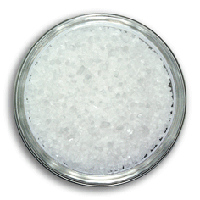 Most burger experts use just a pinch of salt and some fresh-ground pepper. Some add minced garlic or onion (not garlic powder or onion powder—they lack potency) or some Worcestershire sauce. There’s no need to over-season: Quality meat has enough flavor to stand on its own with no seasoning at all. Most burger experts use just a pinch of salt and some fresh-ground pepper. Some add minced garlic or onion (not garlic powder or onion powder—they lack potency) or some Worcestershire sauce. There’s no need to over-season: Quality meat has enough flavor to stand on its own with no seasoning at all.
You can add much more to the mix to create a “specialty” burger—we’ve included a list below.
Photo of sea salt courtesy of Saltworks.us.
3. Form Loose Patties
Aim for 6- or 8-ounce patties. Inexperienced burger makers pack the chopped meat tightly. Don’t: A dense burger is not a juicy burger, and a lightly-shaped burger won’t fall apart. Avoid the temptation to shape and re-shape the meat; don’t compare your patty to perfectly-round patties pressed out by machines or by kitchen professionals using ring molds. Pressing down on the burger with a spatula while it’s cooking compacts the meat and presses out juices.
4. Cook On A Clean Grill
If you’ve cooked other foods (like chicken), clean the grill before you make the burgers. Aside from keeping the flavor of your burgers pure, you don’t want clinging remnants of chicken to ignite. Thickly fold a paper towel, dampen it with salad oil and wipe the hot grill grates to make a nonstick surface.
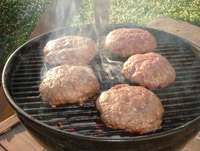 Grilling time for your burgers will vary based on their size and your grill, but estimate 3 minutes per side for rare, 4 minutes for medium. If you’re making cheeseburgers, add the cheese for the final 2 minutes. Grilling time for your burgers will vary based on their size and your grill, but estimate 3 minutes per side for rare, 4 minutes for medium. If you’re making cheeseburgers, add the cheese for the final 2 minutes. - Leave a separate area on the grill to toast buns, otherwise you'll need to clean the grill before toasting. Toast them on the cut side only, for just 1 minute.
Photo courtesy of MorgueFile.
5. Don’t Overcook Your Burger
Because of the E. coli scares, even people who enjoyed their burgers rare or medium rare have been eating them well-done. This robs the meat of its flavor and juiciness—you can pile on ketchup and pickles to compensate, but you’re missing out on delicious beef flavor.
- E. coli outbreaks come from poor-quality animals. If you purchase beef from a quality butcher, you can enjoy a rare burger.
- In the interest of full disclosure, there is also potential salmonella poisoning* for those who like rare meat and poultry and uncooked eggs (e.g. in steak tartare or Caesar salad). Rare beef is cooked to 125°F and salmonella is killed at 160°F. *Diarrhea and stomach cramps, among other symptoms.
6. Look For Better Burger Buns
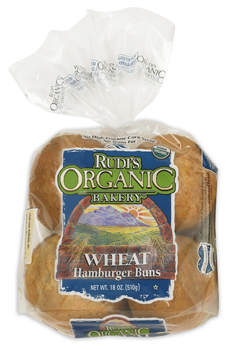 Most supermarket buns are pretty sorry pieces of white bread—the best thing you can do is toast them. A better bet is to look for organic buns. Most supermarket buns are pretty sorry pieces of white bread—the best thing you can do is toast them. A better bet is to look for organic buns.
- Specialty bakers like Rudi’s Organic Bakery produce a nicer product—Rudi’s makes hamburger and hot dog rolls in white, wheat and spelt. (Spelt has become prominent because it can be eaten by people with wheat allergies, but can be even tastier than wheat—try it!) Check traditional supermarkets and natural products stores for whole-grain buns that are healthier and delicious to eat—not just bland holders for the burger.
- For a deluxe bun experience, look for buttery brioche rolls at a your food store or a French bakery.
7. Set Out An Exciting “Burger Bar”
Let people “build their own” burger.
- Salad Components: Lettuce, tomatoes and sweet onions.
- Cheese: Banish anything wrapped in plastic (it’s practically flavorless) and look for exciting cheeses to top that burger, even if you have to slice it yourself. We vote for Cabot Cheddars in Horseradish, Chipotle or Hot Habañero (there’s also a 50% Reduced Fat Pepper Jack and a 75% Reduced Fat Jalapeño).
- Pickles & Relishes: For real excitement, look at the selection from Rick’s Picks and Mama Lil’s Picalilli.
- Ketchup: Commercial ketchups have a huge amount of sugar. Consider the more interesting Heinz Chili Sauce as an alternative, or look at the interesting ketchups at your local specialty food store.
- Mustard: We like to start with Dijon, but there are so many specialty mustards, one could devote months to trying them all. Our favorite: the Dijon-style Roquefort Mustard from Laurent du Clos. A side benefit of mustard: almost no calories.
8. Specialty Burgers
After you’ve mastered your basic burger, you can raise the “stakes” by creating tasty variations:
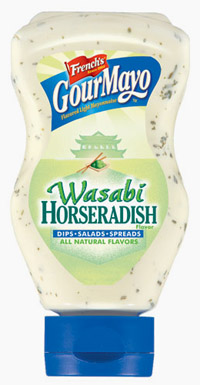 Asian Burger: Use soy sauce instead of salt, and fresh minced ginger. Try mixing in some teriyaki sauce instead of Worcestershire. Serve with wasabi mayonnaise—there are some good ones on the market, like French’s GourMayo, or just mix your own. Asian Burger: Use soy sauce instead of salt, and fresh minced ginger. Try mixing in some teriyaki sauce instead of Worcestershire. Serve with wasabi mayonnaise—there are some good ones on the market, like French’s GourMayo, or just mix your own. - Fiesta Burger: Add chopped jalapeño or hot sauce; top your burger with guacamole or salsa instead of ketchup.
- French Burger: Season meat with Dijon mustard and top with fresh goat cheese.
- Italian Burger: Add fresh-grated Parmesan cheese (not cheese-in-a-can!), serve with marinara sauce instead of ketchup.
Ask family members to come up with burger ideas and hold a “Burger Competition” night to vote for the winner. Let us know your favorites—write to Editors at TheNibble.com.
Lifestyle Direct, Inc. All rights reserved. Photos are copyright of their respective owners.

|





 Most burger experts use just a pinch of salt and some fresh-ground pepper. Some add minced garlic or onion (not garlic powder or onion powder—they lack potency) or some Worcestershire sauce. There’s no need to over-season: Quality meat has enough flavor to stand on its own with no seasoning at all.
Most burger experts use just a pinch of salt and some fresh-ground pepper. Some add minced garlic or onion (not garlic powder or onion powder—they lack potency) or some Worcestershire sauce. There’s no need to over-season: Quality meat has enough flavor to stand on its own with no seasoning at all.  Grilling time for your burgers will vary based on their size and your grill, but estimate 3 minutes per side for rare, 4 minutes for medium. If you’re making cheeseburgers, add the cheese for the final 2 minutes.
Grilling time for your burgers will vary based on their size and your grill, but estimate 3 minutes per side for rare, 4 minutes for medium. If you’re making cheeseburgers, add the cheese for the final 2 minutes.  Most supermarket buns are pretty sorry pieces of white bread—the best thing you can do is toast them. A better bet is to look for organic buns.
Most supermarket buns are pretty sorry pieces of white bread—the best thing you can do is toast them. A better bet is to look for organic buns. Asian Burger: Use soy sauce instead of salt, and fresh minced ginger. Try mixing in some teriyaki sauce instead of Worcestershire. Serve with wasabi mayonnaise—there are some good ones on the market, like French’s GourMayo, or just mix your own.
Asian Burger: Use soy sauce instead of salt, and fresh minced ginger. Try mixing in some teriyaki sauce instead of Worcestershire. Serve with wasabi mayonnaise—there are some good ones on the market, like French’s GourMayo, or just mix your own.